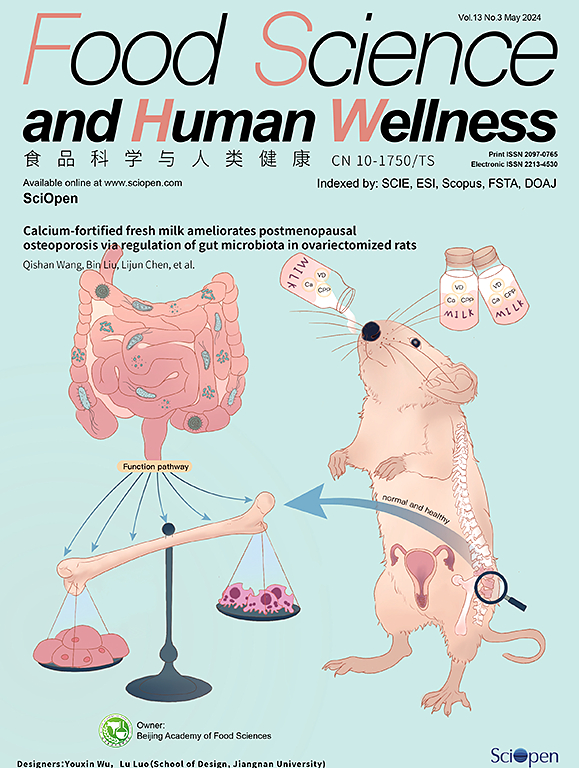Characterization of squash polysaccharide and the anti-diabetic effect on type 2 diabetic rat revealed by urine metabolomics analysis
IF 7.4
1区 农林科学
Q1 FOOD SCIENCE & TECHNOLOGY
引用次数: 0
Abstract
The present study reports the structural characteristics of 3 polysaccharide fractions (SPS-F1, SPS-F2 and SPS-F3) isolated and purified from squash. SPS-F1 (molecular weight (Mw) = 12.30 kDa) and SPS-F2 (Mw = 19.40 kDa) were likely to contain HG and RG-I domain of pectic polysaccharide, respectively. SPS-F2 (Mw = 270.4 kDa) was mainly composed of rhamnose, galactose and arabinose. The treatment with SPS decreased body weight gain, glucose and TG levels in type 2 diabetes rats. Besides, 25 differential metabolites were identified based on urinary metabolomics analysis, which are crucial to the anti-diabetic effect of SPS. The regulation of nicotinamide N-oxide, histamine, cis-aconitate, citrate, L-malic acid, 3-(3-hydroxyphenyl) propanoic acid and N-acetyl-L-aspartic acid were mainly associated with energy metabolism, gut microbiota and inflammation. Study of surface plasmon resonance revealed the binding kinetics with galectin-3 (Gal-3) and fibroblast growth factor 2 (FGF2). The KD values of SPS-F2 and SPS-F3 to Gal-3 were 4.97 × 10-3 and 1.48 × 10-3 mol/L, indicating a weak binding affinity. All 3 fractions showed moderate binding to FGF2 and the affinity was SPS-F3 > SPS-F2 > SPS-F1. Thus, the metabolomics and SPR approach were proved to be a promising tool in exploring the anti-diabetes effects of SPS and provided a deep understanding of the mechanisms.
通过尿液代谢组学分析揭示地瓜多糖的特征及对 2 型糖尿病大鼠的抗糖尿病作用
本研究报告了从地瓜中分离纯化的 3 种多糖组分(SPS-F1、SPS-F2 和 SPS-F3)的结构特征。SPS-F1(分子量 (Mw) = 12.30 kDa)和 SPS-F2(分子量 = 19.40 kDa)可能分别含有果胶多糖的 HG 和 RG-I 结构域。SPS-F2(Mw = 270.4 kDa)主要由鼠李糖、半乳糖和阿拉伯糖组成。用 SPS 治疗可降低 2 型糖尿病大鼠的体重增加、血糖和总胆固醇水平。此外,根据尿液代谢组学分析,还发现了25种差异代谢物,它们对SPS的抗糖尿病作用至关重要。对烟酰胺 N-氧化物、组胺、顺式乌头酸、柠檬酸、L-苹果酸、3-(3-羟基苯基)丙酸和 N-乙酰基-L-天冬氨酸的调节主要与能量代谢、肠道微生物群和炎症有关。表面等离子体共振研究揭示了与加连蛋白-3(Gal-3)和成纤维细胞生长因子 2(FGF2)的结合动力学。SPS-F2 和 SPS-F3 与 Gal-3 的 KD 值分别为 4.97 × 10-3 和 1.48 × 10-3 mol/L,表明结合亲和力较弱。三个馏分都与 FGF2 有中等程度的结合,亲和力分别为 SPS-F3 > SPS-F2 > SPS-F1。因此,代谢组学和 SPR 方法被证明是探索 SPS 抗糖尿病作用的有效工具,并为深入了解其作用机制提供了依据。
本文章由计算机程序翻译,如有差异,请以英文原文为准。
求助全文
约1分钟内获得全文
求助全文
来源期刊

Food Science and Human Wellness
Agricultural and Biological Sciences-Food Science
CiteScore
8.30
自引率
5.70%
发文量
80
审稿时长
28 days
期刊介绍:
Food Science and Human Wellness is an international peer-reviewed journal that provides a forum for the dissemination of the latest scientific results in food science, nutriology, immunology and cross-field research. Articles must present information that is novel, has high impact and interest, and is of high scientific quality. By their effort, it has been developed to promote the public awareness on diet, advocate healthy diet, reduce the harm caused by unreasonable dietary habit, and directs healthy food development for food industrial producers.
 求助内容:
求助内容: 应助结果提醒方式:
应助结果提醒方式:


